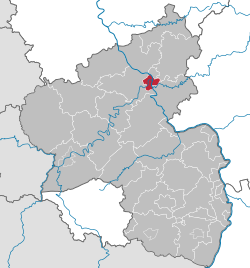
Back Koblenz Afrikaans Koblenz RP ALS Coblenza AN كوبلنتس Arabic كوبلنز ARZ Koblenz AST Koblens Azerbaijani کوبلنتس AZB Кобленц Bashkir Koblenz BAR
Koblenz | |
|---|---|
 View of the Deutsches Eck and Koblenz Old Town | |
| Coordinates: 50°21′35″N 7°35′52″E / 50.35972°N 7.59778°E | |
| Country | Germany |
| State | Rhineland-Palatinate |
| District | Urban district |
| Government | |
| • Lord mayor (2017–25) | David Langner[1] (Ind.) |
| Area | |
• Total | 105.02 km2 (40.55 sq mi) |
| Elevation | 64.7 m (212.3 ft) |
| Population (2022-12-31)[2] | |
• Total | 115,268 |
| • Density | 1,100/km2 (2,800/sq mi) |
| Time zone | UTC+01:00 (CET) |
| • Summer (DST) | UTC+02:00 (CEST) |
| Postal codes | 56001–56077 |
| Dialling codes | 0261 |
| Vehicle registration | KO |
| Website | koblenz.de |
Koblenz (UK: /koʊˈblɛnts/ koh-BLENTS, US: /ˈkoʊblɛnts/ KOH-blents, German: [ˈkoːblɛnts] ⓘ; Moselle Franconian: Kowelenz) is a German city on the banks of the Rhine (Middle Rhine) and the Moselle, a multinational tributary.
Koblenz was established as a Roman military post by Drusus c. 8 BC. Its name originates from the Latin (ad) cōnfluentēs, meaning "(at the) confluence".[3] The actual confluence is today known as the "German Corner", a symbol of the unification of Germany that features an equestrian statue of Emperor William I. The city celebrated its 2,000th anniversary in 1992.
The city ranks as the third-largest city by population in Rhineland-Palatinate, behind Mainz and Ludwigshafen am Rhein. Its usual-residents' population is 112,000 (as of 2015[update]). Koblenz lies in a narrow flood plain between high hill ranges, some reaching mountainous height, and is served by an express rail and autobahn network. It is part of the populous Rhineland.
- ^ Wahl der Oberbürgermeister der kreisfreien Städte, Landeswahlleiter Rheinland-Pfalz, accessed 30 July 2021.
- ^ "Bevölkerungsstand 2022, Kreise, Gemeinden, Verbandsgemeinden" (PDF) (in German). Statistisches Landesamt Rheinland-Pfalz. 2023.
- ^ Chisholm 1911, p. 612.
© MMXXIII Rich X Search. We shall prevail. All rights reserved. Rich X Search




